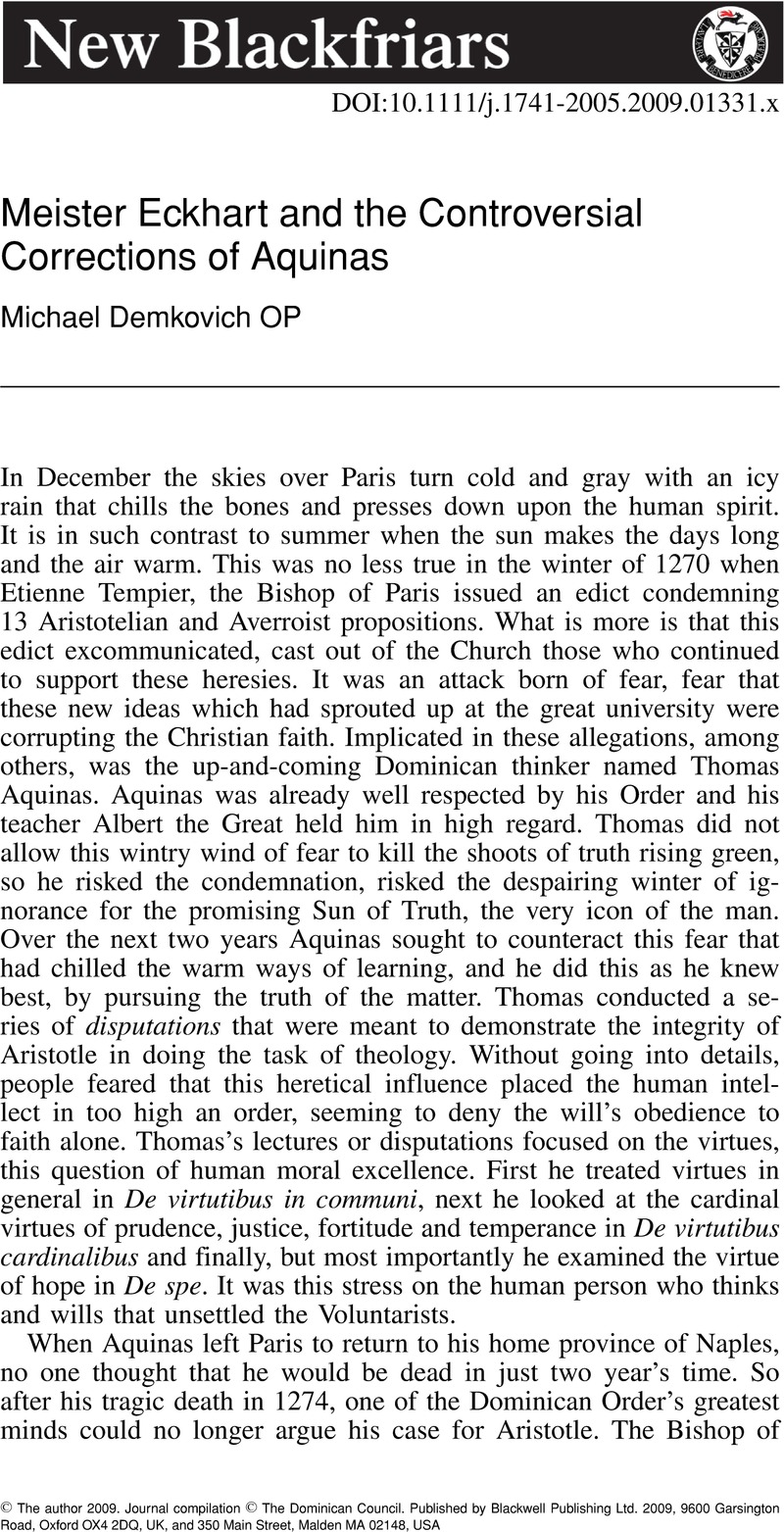Article contents
Meister Eckhart and the Controversial Corrections of Aquinas
Published online by Cambridge University Press: 01 January 2024
Abstract

- Type
- Original Articles
- Information
- Copyright
- Copyright © The author 2009. Journal compilation © The Dominican Council/Blackwell Publishing Ltd. 2009
References
1 This article was delivered at Blackfriars, Oxford as part of the Aquinas Institute lectures May 21, 2009. It develops part of an earlier talk given at the Sixteenth Annual Conference of the Eckhart Society (2003), “Explanatory Shards of the Incarnation in Eckhart's Parisian Questions,” printed in the Eckhart Review (2004) 5–23.
2 Monumenta Ordinis Fratrum Praedicatorum Historica vol. III (Rome, 1898) p. 122. [This same volume is also known as the Acta Capitulorum Generalium, 1220–1303, vol. 1.] Hereafter MOPH.
3 MOPH III p. 199.
4 MOPH III, p. 204.
5 Mark D. Jordan's article “The Controversy of the Correctoria and the Limits of Metaphysics” traces the late thirteenth century struggle between anti-Thomist and Thomist in Speculum 57/2 (1982):292–314.
6 Speculum 57: 293. Jordan cites the 1942 article by Burbach, Maur, “Early Dominican and Franciscan Legislation Regarding St. Thomas,” Mediaeval Studies 4, 139–48CrossRefGoogle Scholar.
7 “The Correctorium Controversy and the Origins of the Usus Pauper Controversy” Speculum 60/2 (1985): 337Google Scholar.
8 Lowe, Elizabeth, The Contested Theological Authority of Thomas Aquinas: The Controversies between Hervaeus Natalis and Durandus of St. Pourçain 1307–1323 (New York: Routledge, 2003)Google Scholar.
9 Speculum 60/2 (1985): 331–342.
10 Jordan, 294. A valuable piece on Thomas Sutton is by Gyula Klima of Fordham University, “Thomas of Sutton on the Nature of the Intellective Soul and the Thomistic Theory of Being”, Aertsen, J. et al. (eds.), Nach der Verurteilung von 1277. Philosophie und Theologie an der Universität von Paris im letzten Viertel des 13. Jahrhunderts, Studien und Texte (Miscellanea Mediaevalia 28)Google Scholar, Walter de Gruyter, Berlin−New York 2001, pp. 436–455. Another valuable work is his paper, “Thomas Sutton and Henry of Ghent on the Analogy of Being” delivered at the International Congress on Medieval Studies, May 2–5, 2002, Kalamazoo, MI
11 MOPH III, p. 235.
12 Jordan, 293–96.
13 Meister Eckhart (Philadelphia: University Pennsylvania Press, 1986) pp. 35–7Google Scholar.
14 Meister Eckhart: Mystic as Theologian. (Rockport, MA: Element, 1991) p. 46Google Scholar.
15 The Mystical Thought of Meister Eckhart (New York: Crossroads, 2001) pp. 4–5Google Scholar.
16 Maurer, A. ed. and trans. Parisian Questions and Prologues (Toronto: Pontifical Institute of Medieval Studies, 1970)Google Scholar.
17 The excellent work by Weisheipl, James A., Friar Thomas d’Aquino. His Life, Thought, and Works (Catholic University of America Press, 1983)Google Scholar includes a valuable summary of Aquinas's works. See p. 386.
18 Weisheipl, p. 78–9.
19 I recommend Kenny's, Anthony Aquinas on Being (Oxford University Press, 2002)CrossRefGoogle Scholar for those desiring a fuller explanation.
20 Lowe, 76, also MOPH III p. 38.
21 I recommend Kurt Flasch's work Von Meister Dietrich zu Meister Eckhart (Hamburg : Meiner, 1984)Google Scholar in the series Corpus philosophorum Teutonicorum Medii Aevi; and Wallace's, William A. The scientific methodology of Theodoric of Freiberg; a case study of the relationship between science and philosophy (Fribourg, Switzerland, University Press, 1959)Google Scholar.
22 For a complete study of motion and Aquinas's understanding see Oliver's, Simon Philosophy, God and Motion (New York: Routledge, 2005)Google Scholar.
23 MOPH III pp. 64–5.
24 Weisheipl p. 338.
- 2
- Cited by




